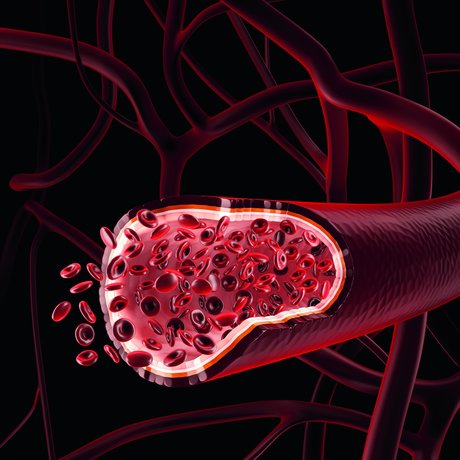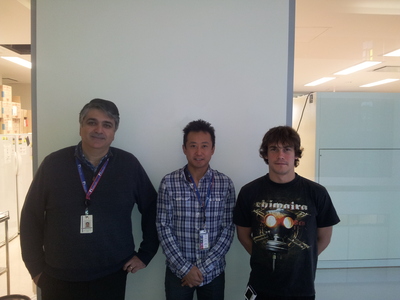The microRNA perspective

The persistently high blood glucose levels associated with diabetes can, over time, cause damage to blood vessels that result in so-called diabetes-related complications. Preventing or reducing diabetes-related complications in the kidney is the focus of some of the work currently underway at the Baker IDI.
Better understanding the mechanisms underlying diabetic nephropathy and developing new treatments to reduce or restore the damage present in chronic kidney disease is also the focus of work by Dr Phillip Kantharidis, who heads the Genomics of Diabetes Complications Unit at the Baker Institute in Melbourne.

A key player for Kantharidis in this quest is microRNA (miRNA), a member of the small noncoding RNA family of molecules formerly known as ‘junk RNA’.
MicroRNAs are about 20-25 nucleotides long and make up about 3-10% of all the small noncoding RNAs found in cells.
“This is a relatively new area,” said Kantharidis. “MicroRNAs were first identified about 20 years ago and were thought to be peculiar to worms and yeast. Over the last decade not only have they been found in most living cells, but their huge influence on biological processes and in human disease has been recognised.”
A promiscuous molecule
MicroRNAs are important in the normal functioning of cells and regulate numerous biological functions, such as basic cell signalling and tissue architecture.
“MicroRNAs act as fine regulators of gene expression by binding to the 3′ end of messengerRNA (mRNA) molecules resulting in decreased protein translation,” explained Kantharidis.
They are also implicated in many cell pathologies and contribute to the development and progression of nephropathy by altering the expression of target genes which are important to normal kidney function.
In diabetic kidney disease the kidney undergoes an increase in collagen production, causing its structure to become fibrotic and decreasing its ability to conduct its filtration function. The high-glucose environment, along with factors such as transforming growth factor-β (TGF-β), drive this increase in collagen and matrix protein production.
Directly targeting of TGF-β as an anti-fibrotic treatment is problematic because of its critical role in immune surveillance. Thus, one tactic Kantharidis’s team is pursuing is to identify new treatment targets, such as miRNAs.
A number of miRNAs are now known to play a role in nephropathy and several of these are regulated by TGF-β.
“We were initially interested in whether miRNAs were altered in diabetic nephropathy and therefore changing the translation of important genes in the kidney,” said Kantharidis. “We found the level of a number miRNAs were significantly reduced. Importantly, these microRNAs targeted collagen and matrix proteins, leading to the increased expression of these genes.”
But this is not a simple task. As Kantharidis says, miRNAs are promiscuous molecules - one miRNA can bind up to one thousand genes.
“One transcription factor or a single RNA can be targeted by many different miRNAs,” he said. “And one miRNA can bind multiple RNAs, at a single or multiple sites, leading to a very complex regulatory circuit.”
Small molecule inhibitors
Kantharidis’s team has identified five or six primary miRNAs that are altered in kidney disease. One of these is increased while the others are decreased in the diabetic kidney. It is early days, but these are potential candidates for developing a potential treatment.
“One of the miRNAs we recently identified is an amplifier of profibrotic signals in the kidney,” Kantharidis said. “We believe that by knocking down this miRNA we may be able to slow the progression of the kidney disease.”
He expects the side effects will be minimal because miRNA molecules are fine regulators of expression and do not act as master switches to turn genes on and off.
“Drugs that inhibit certain microRNAs are being used in cancer research. We are interested in using some of these as they appear to target microRNAs relevant to kidney disease as well,” he said, adding that a number of companies are developing microRNA therapeutic products for the treatment of hepatitis C and heart disease.
They will start by looking at how to restore the expression of miRNAs by using these small molecule inhibitors in animal models of diabetes to assess their effect on kidney function.
“Our interest is in how miRNAs are dysregulated, up or down, in diabetic kidney disease and whether their expression can be restored to reduce or reverse kidney disease,” he added.
Potential biomarkers
Kantharidis says miRNAs appear to be fairly stable in biological fluids. They have conducted next-generation sequencing on miRNAs released from cells that have been given various treatments, as well as miRNAs released into blood and urine.
“There are a lot of microRNAs in serum and urine, and they are found bound to RNA binding proteins or in small vesicles,” added Kantharidis. “They are transported in the plasma and in some cases have been shown to act at distal sites in the body, influencing gene expression in other organs, but how this works is not well understood.”
The presence of miRNAs in biofluids means they represent a potential source of readily available biomarkers for many diseases, including diabetic nephropathy.
Kantharidis’s team is also looking at identifying miRNAs in urine as potential biomarkers of diabetic kidney disease.
A network influence
The concept of linear signalling goes out the window when miRNAs are around. Multiple miRNAs can target a single RNA, a single miRNA can target multiple RNAs and a single dysregulated miRNA can influence an entire signalling network. Understanding how they regulate and are regulated by factors that contribute to kidney disease is certainly a challenge.
“In one kidney cell that we studied, 50% of the total population of miRNAs were made up of one single miRNA,” he said. “The thinking is that abundant microRNAs maintain the cell phenotype, but once a cell is pushed past phenotypic boundaries, a resetting of the miRNAs expression profile occurs to adapt to the new phenotype.”
Kantharidis also presented this work at the 22nd World Diabetes Congress, which was held in Melbourne towards in December 2013, and has a publication in the pipeline.
Real-time sequencing helps combat golden staph infections
Tracking bacterial changes during serious Staphylococcus aureus (golden staph) infection...
Single-cell sequencing capability boosted in South Australia
The South Australian Genomics Centre has become the first certified service provider in...
Biomaterial helps to reverse aging in the heart
The discovery could open the door to therapies that rejuvenate the heart by changing its cellular...




